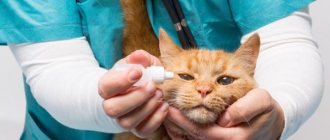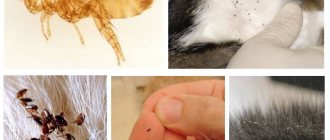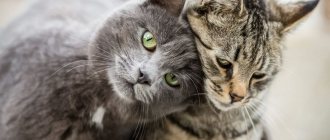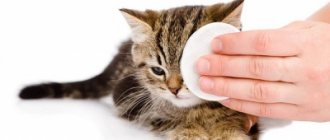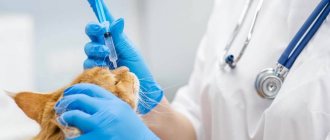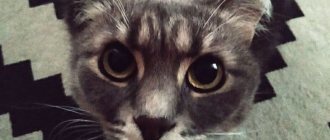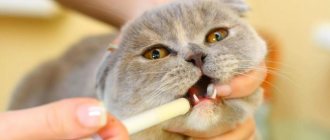For eye diseases in pets, experts most often prescribe drop therapy. Only a veterinarian at an appointment can competently explain how to put drops into a cat’s eyes. Knowing the features of instillation, you can perform the procedure yourself at home.
Typically, the doctor prescribes such procedures for several days, and instillation will need to be done two or three times during the day. Properly performed manipulation should not become an unpleasant procedure for the cat.
IMPORTANT! If 2 medications are prescribed, instillation should be carried out at intervals of 10-15 minutes. Means used simultaneously will not give a positive result.
Preparing the owner and cat for a medical procedure
Before the procedure, the animal owner must thoroughly wash their hands, disinfect them and wear gloves. There must be a mask on the face.
For a cat you need to prepare everything you need:
- warm boiled water;
- clean soft towel;
- a syringe without a needle or a pipette;
- 2 sterile cotton swabs (for each eye).
The drug must be removed from the cat's field of view. First, taking her in your arms, you need to calm her down, stroke her, and talk to her in a gentle voice. The animal must be securely restrained. A calm cat can be held in your arms or simply pressed lightly against the sofa. A restless one can be wrapped in a towel, leaving only the face visible.
It is good to attract an assistant who will hold the pet or instill medicine.
Emotional mood
Do not forget to calm the cat throughout the procedure by talking affectionately to it. This works best if you imagine that in front of you is a very small child who does not yet speak, whom you persuade to eat another spoon “for dad” and “for mom.” At the same time, women instinctively raise their voices and develop gentle melodious intonations.
Naturally, you can say whatever you want and even perform children’s sayings and nursery rhymes - practice shows that they have the same calming effect on cats as they do on babies. Try not to be nervous yourself, behave calmly and confidently, and we hope our advice will help you with this.
Sequence of eye drops for a cat
Indications for eye treatment are pathological processes. For example, this is redness of the mucous membrane of the organ of vision, purulent discharge and gluing of the eyelids.
Before instilling medication into the eyes, you need to gently and carefully wipe the area around the eyes with swabs soaked in warm water to remove pus and other contaminants. Instead of water, you can use any warm tea or chamomile flower decoction.
Procedure:
- Rinse the mucous membranes of one eye first, and then the other with a cleansing solution. Remove wet residue.
- Open the tube with the pharmaceutical preparation.
- Slightly pull the eyelid down and squeeze 2-3 drops of the product into the resulting gap. During the procedure, you need to talk to the animal gently, this will calm him down.
- Massage the eyelid for 5-7 seconds for the best distribution of the medicine. The liquid should not leak onto the wool.
- Repeat the manipulation with the second eye. Do not let go of the animal for 2-3 minutes so that it does not scratch the eyeball.
The pet will feel itching or burning after the procedure. Sometimes the cat may feel severe pain. At this point she will become restless or even aggressive.
The animal needs to be rewarded with its favorite treat.
Which drops are best to use?
Anandin:
- Therapeutic effect: immunostimulant – anti-inflammatory, antimicrobial, regenerative effect.
- Active ingredient: glucoaminopropylacridone.
- Dosage and frequency of administration: 20 mg per 1 kg of body weight, 2-3 times a day.
Fosprenil:
- Therapeutic effect: antiviral drug.
- Active ingredient: disodium salt of polyprenols phosphate.
- Dosage and frequency of administration: For kittens: single dose - 0.3 cc. cm/kg; daily dose - 0.9-1.2 cubic meters. cm/kg.
- For adult cats: single dose - 0.2 cc. cm/kg, daily dose - 0.6-0.8 cc. cm/kg.
Maxidin:
- Therapeutic effect: immunomodulator
- Active ingredient: IR spectrum bis (pyridine-2,6-dicarboxylate).
- Dosage and frequency of administration: 1-2 drops (in each nostril) 2-3 times a day.
Thymogen:
- Therapeutic effect: immunostimulant.
- Active ingredient: alpha-glutamyl-tryptophan.
- Dosage and frequency of administration: 1-2 drops (in each nostril) 1 time per day.
Animal care tips
When treating inflammatory eye diseases, animals are most often prescribed instillation - drip administration of solutions of medicinal agents. When instilling, it is necessary to correctly follow all the rules and recommendations of specialists on the administration of pharmaceuticals.
Only a veterinarian can prescribe medication correctly. A specialist should also monitor and adjust the dynamics of therapy. Uncontrolled or illiterate use of the drug can only worsen the situation. Medicines should not be expired.
Advice! The procedure should be carried out as naturally as possible, otherwise the animal will be scared and not allow the drops to be administered. The effectiveness of the manipulation will be much higher if the animal sits or lies in a calm state.
If the kitten cannot wash itself, then the owner should help it daily using boiled warm water or weak tea leaves.
Inflammation of the eyes is a common symptom in small kittens. A problem detected in time will help to avoid major health problems, and competent assistance will stop the development of the disease. The health of a pet primarily depends on its owner.
Help from professionals
If, despite all your efforts, the animal does not get better within 7-10 days, but, on the contrary, its condition worsens, then you should immediately contact a veterinary clinic to avoid the development of pneumonia. The same should be done if a cat’s usual runny nose turns purulent. These symptoms indicate the animal’s weak immunity and require complex drug treatment, which can only be prescribed by a doctor. Now you know why your furry pet may have a runny nose, and how to help him get rid of this unpleasant health problem.
Take the advice of experts and be kind to your pet, because now, more than ever, he needs care and your attention.
Having recovered, he will return all the affection to you in full and will gratefully rub against your legs. Health to your purr and sweet cat dreams!
Common diseases
Classification of eye pathologies in cats, symptoms characteristic of each disease:
| Disease | Description and symptoms |
| Conjunctivitis | Occurs due to the entry of a foreign body, trauma to the mucous membrane, exposure to chemicals, and diseases of infectious origin. Characterized by swelling in the eyelid area and a large volume of purulent discharge. The disease can be transmitted from a sick cat to a healthy one. |
| Glaucoma | An increase in pressure in the eyeball can cause clouding of the cornea. The pathology often causes blindness. |
| Keratitis | Inflammation of the cornea is observed with clouding of the mucous membrane of the eyes and increased tearing. |
| bulging eye | Protrusion of an organ occurs due to its damage or the development of a neoplasm. Pathology is fraught with organ loss. |
| Violation of the lacrimation process | Blockage of the tear duct, as well as excessive secretion of fluid. The animal experiences severe discomfort, and the ability to see deteriorates. |
| Cataract | Characterized by clouding of the lens. The eye becomes smoky usually in adult animals and cats suffering from diabetes. |
To prevent the development of any eye disease, a systematic examination of your pet by a veterinarian is required. Without timely treatment, not only a malfunction of the visual system is possible, but also an increased risk of vision loss.
Tsiprovet
Ciprofloxacin, which is the basic substance of the drug Ciprovet, causes anti-inflammatory, antimicrobial and bactericidal effects. Medicine is prescribed if eye diseases in a cat are caused by the active development of Pseudomonas aeruginosa, mycoplasma, Staphylococcus aureus, and chlamydia. Tsiprovet is used during the preparation of animals for eye surgery, as well as at the rehabilitation stage.
When the initial symptoms of the disease are detected, one drop of the drug is administered three times a day. The course duration is seven days. In complicated cases, when the eyes begin to fester, the dose for adult cats is doubled. For kittens older than seven days, one drop is enough.
Contraindications, adverse reactions
The medication does not have an extensive list of prohibitions for use. Among them, only individual high susceptibility to the components of the solution. During the period of bearing a child, use with great caution is allowed. Prohibited during breastfeeding.
Side effects may include allergic manifestations, burning after instillation, itching, temporary hyperemia of the mucous membrane of the eyes, thickening of the eye tissue, lacrimation. Discomfort usually occurs on its own. If complications persist for a long time, the eyes should be rinsed with water. You need to see a doctor. In general, the drug is considered safe.
Reviews
On the Internet you can find various reviews of Emoxipin eye drops from both doctors and patients.
Ophthalmologists note a negative property of the drug - the ability to greatly irritate the eyes during installation. I also don't like the lack of proven effectiveness. Proponents of the drug point to its good ability to resolve subconjunctival hemorrhages and improve blood microcirculation.
Patients also do not always notice positive dynamics after instillation; they do not like the strong burning sensation.
Treatment of rhinitis in a cat
A runny nose in cats can be treated at home after consulting a veterinarian. It is he who finds out the causes of the disease that need to be eliminated. Self-medication is fraught with serious consequences, since you can hide the symptom of a dangerous disease, waste precious time by choosing the wrong method. This applies, for example, to the case when lymphocytic-plasmacytic rhinitis occurs in cats - a disease that has not been fully studied, but is progressing very quickly.
Treatment of a runny nose in a cat begins with eliminating the cause; for infectious diseases, an antibiotic is prescribed. The most popular medications are Amoxiclav and Baytril.
In the presence of viral infections, use Neotime, Vitafel, Giskan, and in case of fungal disease, Biopirox. What medications to treat a runny nose in a cat can only be prescribed by a specialist, who also indicates the dosage and controls the therapeutic process.
Crusts on the animal’s nose should be removed with a cotton swab disinfected in a solution of hydrogen peroxide.
If there is severe congestion, then it is necessary to use nasal drops for cats that constrict blood vessels. They are instilled into each nostril, a couple of drops, for a week. This is done only after removing the caked discharge.
Do not use cosmetics or cleaning products in the presence of your kitten that they may inhale. Source: Flickr (changing_light)
The choice of drops for a runny nose in cats is different from that in humans. Preparations for animals have not only a narrowing effect, but also an immunostimulating effect, therefore they only help with the infectious nature of the disease. If a cat has allergic rhinitis, then local instillation will not be effective; antihistamines and removal of the source of infection are required.
The most effective nasal drops for cats are:
- "Maksidin";
- "Anandin";
- "Timogen"; "Naphthyzin";
- "Derinat";
- "Galazolin";
- "Nazivin."
For kittens use baby drops:
- "Aquamaris";
- "Protargol";
- "Pinosol";
- "Collargol."
You should not bury them often, or carry out the course for a long time, this aggravates the situation and leads to drying out. To rinse the nose, solutions of table salt, boric acid, tannin, soda, and saline are used. The cat is wrapped in a towel, the liquid is drawn into a syringe without a needle, and injected into the nostrils with gentle pressure.
Also, for treatment, warming is used by applying a bag of heated sand or a chicken egg that has not yet cooled down after cooking to the pet’s nose. The procedure is accompanied by copious liquid discharge, which is removed with a cotton swab.
During treatment, one should not forget about the general strengthening of the body’s defenses; the animal should be given a lot of vitamins, fed properly, and avoid hypothermia and contact with pathogens. If your cat has a runny nose, treating it at home should help, but only after consulting a veterinarian.
Mechanism of action of Emoxipin
According to the instructions, Emoxipin has a retinoprotective effect. This means that the composition is:
- protects eye tissue from the negative effects of bright light;
- reduces the ability of blood vessels, including small capillaries, to pass various substances through their walls;
- reduces blood thickness;
- expands the lumen of the coronary vessels;
- helps in resolving hemorrhages inside the eye.
